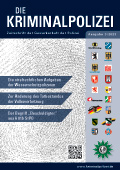Eine entscheidungspsychologische Lesart von digitalen Varianten des Vorkassebetrugs
Von Till Neuhaus M.Ed., M.A., M.A., Bielefeld
Anmerkungen
- Der Autor ist Wissenschaftlicher Mitarbeiter an der Universität Bielefeld. An der Fakultät für Erziehungswissenschaften forscht und lehrt er zu pädagogischen Entscheidungsprozessen und beschäftigt sich darüber hinaus mit entscheidungspsychologischer Forschung in anderen Kontexten.
- Vgl. Park, Y., Jones, J., McCoy, D., Shi, E., & Jacobsson, M. (2014). Scambaiter: Understand-ing Targeted Nigerian Scams on Craigslist. NDSS Internet Society, 1-15.
- Die idealtypischen Charakteristika des Nigerian Scam werden in folgenden Publikationen bei-nah vollumfänglich skizziert: Dyrud, M. A. (2005). „I Brought You A Good News”. An Analysis of Nigerian 419 Letters. Proceedings of the 2005 Association for Business Communication (Annunal Convention); Schaffer, D. (2012). The Language of Scam Spams: Linguistic Fea-tures of the “Nigerian Fraud” E-Mails. Review of General Semantics, 69(2), 157-179.
- Vgl. Smith, A. (2009). Nigerian Scam E-Mals and the Charms of Capital. Cultural Studies, 23(1), 27-47.
- Ausführungen zu den Grunddynamiken des Nudgings sowie der assoziierten Denksysteme, s. Thaler, R. H. & Sunstein, C. R. (2017). Nudge - Wie man kluge Entscheidungen anstößt (Vol. 7). Berlin: Ullstein/Econ Verlag; siehe ebenso Kahneman, D. (2012). Schnelles Denken, langsames Denken (Vol. 8). München: Penguin Verlag/Random House.
- Vgl. McNeil, B., Pauker, S., Sox, H., Jr., Tversky, A. (1982). On the elicitation of prefer-ences for alternative therapies. New England Journal of Medicine, 306, 1259-1262.
- Vgl. Konnikova, M. (2016). The Confidence Game – Why we fall for it…every time. Pen-guin/Random House. New York.
- Cgl. Kich, M. (2005). A Rhetorical Analysis of fund-raiser-scam solicitations. Cercles, 14, 129-142.
- Zur ökonomischen Struktur des Nigerian Scam sowie dem Prinzip der Selbstselektion siehe Herley, C. (2012). Why do Nigerian Scammers Say They are from Nigeria? Microsoft Research: One Microsoft Way, 1-14. Retrieved from www.microsoft.com/en-us/research/wp-content/uploads/2016/02/WhyFromNigeria.pdf.
- Kanich, C., Kreibich, C., Levchenko, K., Enright, B., Voelker, G. M., Paxson, V. & Savage, S. (2008). Spamalytics: An Empirical Analysis of Spam Marketing Conversion. Proceedings of the 15th ACM Conference on Computer and Communications Security, 1-12.
- Vgl. Neuhaus, T. (2020). A (Nudge) Psychological Reading of the Nigerian Scam. Brolly – Journal of Social Science 3(3). 7-28.
- Für die Wirkung von Autorität, Reziprozität, Sympathie, Knappheit sowie dem später diskutier-ten Wunsch nach Konsistenz, s. Cialdini, R. (2021). Influence – The Psychology of Persua-sion. Harper Collins.
- Levine, T. R. (2014). Truth-default theory (TDT) a theory of human deception and deception detection. Journal of Language and Social Psychology, 33(4), 378-392.
- Vgl. Cialdini, R. B. (1987). Compliance Principle of Compliance Professionals. In: M. P. Zanna, J. M. Olson, & C. P. Herman (Eds.), Social Influence: The Ontario Symposium (Vol. 5, pp. 165-184). Psychology Press.
- Milgram, S. (1965). Some Conditions of Obedience and Disobedience to Authority. Human Relations, 18(1), 57-76.
- Vgl. Cialdini, R. B. (2003). The Power of Persuasion - Putting the Science of Influence to work in Fundraising. Stanford Social Innovation Review. 17-27.
- Vgl. Loomes, G. & Sudgen, R. (1983). A Rationale for Preference Reversal. American Economic Review, 73, 428-43.
- Vgl. Bergiel, B. J., Bergiel, E. B. & Balsmeier, P. W. (2008). Internet Cross Border Crime: A growing Problem. Journal of Website Promotion, 3(3/4), 133-142.
- Zum Nutzen und Ablauf von Reziprozität, siehe Cox, J. C. (2004). How to identify trust and reciprocity. Games and Economic Behavior, 46, 260-281.
- Vgl. Cialdini, R. B. (2003). The Power of Persuasion - Putting the Science of Influence to work in Fundraising. Stanford Social Innovation Review. 17-27.
- Cialdini, R. B. & Goldstein, N. J. (2002). The Science and Practice of Persuasion. Cornell Hotel and Restaurant Administration Quaterly. 40-50.
- Vgl. Sagarin, B. J./Mitnick, K. D. (2012). The Path of Least Resistance. In: D. T. Kenrick, N. J. Goldstein, & S. L. Braver (Eds.), Six Degrees of Social Influence - Science, Application, and the Psychology of Robert Cialdini (pp. 27-38). Oxford: Oxford University Press.
- Hobson, R. P. (2012). Emotion as Personal Relatedness. Emotion Review, 4(2), 169-175.
- Festinger, L. (1957). A theory of cognitive dissonance. Stanford, Calif: Stanford University Press.
- Rogers, C. R. (1957). The necessary and sufficient conditions of therapeutic personality change. Journal of Consulting Psychology, 21, 95-103.
- Neuhaus, T. (2021). A Nudge Psychology Perspective on Digital Marketing and Communication: Learning from the Nigerian Scam. In: María Dolores Olvera-Lobo, Juncal Gutiérrez-Artacho, Irene Rivera-Trigueros, Mar Díaz-Millón (Eds.). Innovative Perspectives on Corporate Communication in the Global World (S. 122-140). IGI Global Publishing. Hershey, Pennsylvania.
- Tversky, A./Kahneman, D. (1991). Loss Aversion in Riskless Choice: A Reference- Dependent Model. The Quarterly Journal of Economics, 106 (4), 1039-1061.
- Tversky, A./Kahneman, D. (1981). The Framing of Decisions and the Psychology of Choice. Science, 210, 453-458.
Service
Aktivitäten
Aktuelle Ausgabe

Mit ihrem aktuellen und vielfältigen Themenspektrum, einer Mischung aus Theorie und Praxis und einem Team von renommierten Autorinnen und Autoren hat „Die Kriminalpolizei“ sich in den vergangenen Jahren einen ausgezeichneten Ruf erworben.
Erklärung einschlägiger Präventions-Begriffe
Meist gelesene Artikel
RSS Feed PolizeiDeinPartner.de
PolizeideinPartner.de - Newsfeed
-
Wie Betrüger Künstliche Intelligenz nutzen
Wenn uns jemand darauf aufmerksam macht, dass eine Überweisung getätigt wurde, die wir nicht...
-
Datenklau durch Scraping
Es gehört mittlerweile schon zur Normalität des Internets, dass immer wieder Fälle von...
-
Mehr Falschgeld in Deutschland
Ein Dutzend Vermögende sind 2023 in Deutschland beim Barverkauf ihrer teuren Uhren oder Autos von...
-
Verbraucherschutz-Training für Jugendliche
Gefahren durch Fake-Shops und Cyberkriminelle
-
Sommerreifen mit Bedacht wechseln!
Kälteeinbrüche auch im April möglich
-
Mehr Informationssicherheit für Feuerwehren
BSI und Feuerwehrverband starten gemeinsame Initiative
-
Statistik: Zahl der Verkehrstoten ist 2023 gestiegen
TÜV und DVR fordern Konsequenzen








